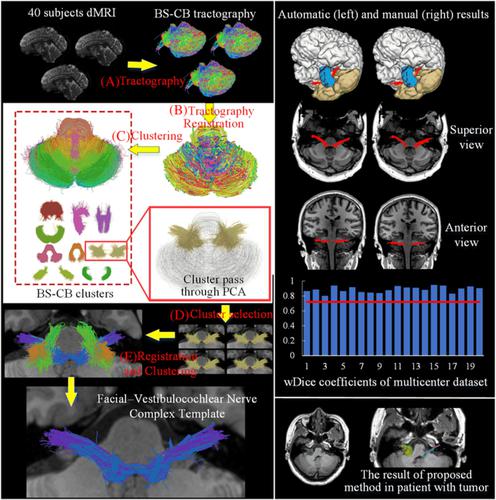当前位置:
X-MOL 学术
›
NMR Biomed.
›
论文详情
Our official English website, www.x-mol.net, welcomes your
feedback! (Note: you will need to create a separate account there.)
Automated facial–vestibulocochlear nerve complex identification based on data-driven tractography clustering
NMR in Biomedicine ( IF 2.7 ) Pub Date : 2021-09-06 , DOI: 10.1002/nbm.4607 Qingrun Zeng 1, 2 , Mengjun Li 3, 4 , Shaonan Yuan 1, 2 , Jianzhong He 1, 2 , Jingqiang Wang 1, 2 , Zan Chen 1, 2 , Changchen Zhao 1, 2 , Ge Chen 4 , Jiantao Liang 4 , Mingchu Li 4 , Yuanjing Feng 1, 2
NMR in Biomedicine ( IF 2.7 ) Pub Date : 2021-09-06 , DOI: 10.1002/nbm.4607 Qingrun Zeng 1, 2 , Mengjun Li 3, 4 , Shaonan Yuan 1, 2 , Jianzhong He 1, 2 , Jingqiang Wang 1, 2 , Zan Chen 1, 2 , Changchen Zhao 1, 2 , Ge Chen 4 , Jiantao Liang 4 , Mingchu Li 4 , Yuanjing Feng 1, 2
Affiliation

|
Small size and intricate anatomical environment are the main difficulties facing tractography of the facial–vestibulocochlear nerve complex (FVN), and lead to challenges in fiber orientation distribution (FOD) modeling, fiber tracking, region-of-interest selection, and fiber filtering. Experts need rich experience in anatomy and tractography, as well as substantial labor costs, to identify the FVN. Thus, we present a pipeline to identify the FVN automatically, in what we believe is the first study of the automated identification of the FVN. First, we created an FVN template. Forty high-resolution multishell data were used to perform data-driven fiber clustering based on the multishell multitissue constraint spherical deconvolution FOD model and deterministic tractography. We selected the brainstem and cerebellum (BS-CB) region as the seed region and removed the fibers that reach other brain regions. We then performed spectral fiber clustering twice. The first clustering was to create a BS-CB atlas and separate the fibers that pass through the cerebellopontine angle, and the other one was to extract the FVN. Second, we registered the subject-specific fibers in the space of the FVN template and assigned each fiber to the closest cluster to identify the FVN automatically by spectral embedding. We applied the proposed method to different acquirement sites, including two different healthy datasets and two tumor patient datasets. Experimental results showed that our automatic identification results have ideal colocalization with expert manual identification in terms of spatial overlap and visualization. Importantly, we successfully applied our method to tumor patient data. The FVNs identified by the proposed method were in agreement with intraoperative findings.
中文翻译:

基于数据驱动的牵引成像聚类的面部-前庭蜗神经复合体自动识别
小尺寸和复杂的解剖环境是面部-前庭蜗神经复合体 (FVN) 纤维束成像面临的主要困难,并导致纤维取向分布 (FOD) 建模、纤维跟踪、感兴趣区域选择和纤维过滤方面的挑战。专家需要丰富的解剖学和纤维束成像经验,以及大量的劳动力成本,才能识别 FVN。因此,我们提出了一个自动识别 FVN 的管道,我们认为这是对 FVN 自动识别的首次研究。首先,我们创建了一个 FVN 模板。基于多壳多组织约束球形反卷积 FOD 模型和确定性纤维束成像,使用 40 个高分辨率多壳数据执行数据驱动的纤维聚类。我们选择脑干和小脑 (BS-CB) 区域作为种子区域,并去除到达其他大脑区域的纤维。然后我们进行了两次光谱纤维聚类。第一个聚类是创建一个BS-CB图谱并分离通过小脑桥脑角的纤维,另一个是提取FVN。其次,我们在 FVN 模板的空间中注册特定主题的纤维,并将每根纤维分配到最近的簇,以通过光谱嵌入自动识别 FVN。我们将所提出的方法应用于不同的采集站点,包括两个不同的健康数据集和两个肿瘤患者数据集。实验结果表明,我们的自动识别结果在空间重叠和可视化方面与专家人工识别具有理想的共定位。重要的,我们成功地将我们的方法应用于肿瘤患者数据。通过所提出的方法确定的 FVN 与术中发现一致。
更新日期:2021-09-06
中文翻译:

基于数据驱动的牵引成像聚类的面部-前庭蜗神经复合体自动识别
小尺寸和复杂的解剖环境是面部-前庭蜗神经复合体 (FVN) 纤维束成像面临的主要困难,并导致纤维取向分布 (FOD) 建模、纤维跟踪、感兴趣区域选择和纤维过滤方面的挑战。专家需要丰富的解剖学和纤维束成像经验,以及大量的劳动力成本,才能识别 FVN。因此,我们提出了一个自动识别 FVN 的管道,我们认为这是对 FVN 自动识别的首次研究。首先,我们创建了一个 FVN 模板。基于多壳多组织约束球形反卷积 FOD 模型和确定性纤维束成像,使用 40 个高分辨率多壳数据执行数据驱动的纤维聚类。我们选择脑干和小脑 (BS-CB) 区域作为种子区域,并去除到达其他大脑区域的纤维。然后我们进行了两次光谱纤维聚类。第一个聚类是创建一个BS-CB图谱并分离通过小脑桥脑角的纤维,另一个是提取FVN。其次,我们在 FVN 模板的空间中注册特定主题的纤维,并将每根纤维分配到最近的簇,以通过光谱嵌入自动识别 FVN。我们将所提出的方法应用于不同的采集站点,包括两个不同的健康数据集和两个肿瘤患者数据集。实验结果表明,我们的自动识别结果在空间重叠和可视化方面与专家人工识别具有理想的共定位。重要的,我们成功地将我们的方法应用于肿瘤患者数据。通过所提出的方法确定的 FVN 与术中发现一致。











































 京公网安备 11010802027423号
京公网安备 11010802027423号